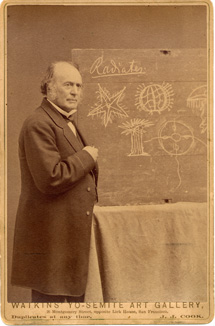

|
Jean Louis Rodolphe Agassiz (1807-1873) was one of the most celebrated naturalists of the 19th century. He has also become quite controversial, because he was one of the major advocates for the theory of polygenesis, the idea that not only are there distinct human races, but that each of these races was separately created, with its own special attributes, to inhabit a specific geographic, environmental region. Louis Agassiz was born in Switzerland and educated there and in Germany. He then went to Paris, where he became the student of Alexander von Humboldt (1769-1859), the great Prussian geographer, and Georges Cuvier (1769-1832), the equally influential zoologist who was instrumental in establishing the fields of comparative anatomy and paleontology. Agassiz became the first to present scientific evidence that the Earth had undergone an Ice Age, and he also became famous for his system of classification of fish, and he developed the scientific system of zoological classification for all genera. Agassiz's growing international renown resulted in his appointment as professor of zoology and geology at Harvard University in 1847. He founded the Museum of Comparative Zoology there in 1859, and he lived in the United States until his death in 1873. In his portrait here, Agassiz stands before a chalkboard, with an illustration of various species of radiates, a form of invertebrate marine life that involve symmetrical formation around a central hub (such as starfish, jellyfish, etc.). The portrait was taken late in his life, when Agassiz traveled to California in 1872 for an expedition and to give lectures in San Francisco. It shows him engaged in the work that most fascinated him: the classification of forms of life, and he is posed as if lecturing. For Agassiz, educating the public about the discoveries of naturalism was an important part of his calling. It was the task of classifying species that brought Agassiz to the question of race. Like many other scientists of his day, Agassiz was convinced that the human species was divided into races, and so the question was, what was the origin and basis of these different races? Agassiz was a biological idealist, a position he learned from his mentor, Cuvier. What idealism meant in biology was that all biological forms had their origin in the mind of God. As their Creator, God had a preexisting idea of each form of life and where it should fit into the overall plan of life on Earth. From this basis, Agassiz proposed his theory of polygenesis (literally, multiple births or origins): that each of the human races had a separate creation, that each race was created to be suited to a specific environmental context, and that therefore each race had particular physical and mental attributes appropriate to its intended context. Agassiz's theory, which he developed in the late 1840s, was tremendously controversial, because it seemed to contradict the biblical story of a single origin (monogenesis) of the human race with Adam and Eve. Agassiz was a believer, and he insisted that his theory did not contradict the biblical sense of a spiritual unity of humankind. Furthermore, when Charles Darwin (1809-1882) published On the Origin of Species in 1859, which argued that the various forms of life derive from the blind struggle of evolution, Agassiz became one of his chief opponents due to his idealist belief that the "origin" of species is the idea of each species in the mind of a creator God. This portrait of Agassiz should be connected to another photograph in the exhibition, the daguerreotype of Delia. In 1850, Agassiz commissioned a photographer in Charleston, South Carolina, to take pictures of slaves. The purpose of these images, some of the earliest images in ethnography, was for use as illustrations to demonstrate Agassiz's theory of polygenesis. Agassiz never published these images, and they remained forgotten until they were rediscovered in 1976. A good source for his biography is Louis Agassiz: A Life in Science, by Edward Lurie (Baltimore and London: The Johns Hopkins University Press, 1988 [1960]). |